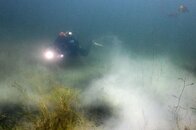Ryan Neely
Contributor
There's nothing to do with Deep Purple here; this is a legitimate question.
There's this lake my wife and I like to dive at least once a year in our neck of the woods (northern Minnesota). The particular dive site is shallow, maybe a maximum depth of thirteen feet. It's fun to snorkel, but we like to dive it to practice buoyancy and photography skills.
One particular corner of this lake always has a heavy layer of mist draping the bottom. It's right at thirteen feet of depth. If you fan away the mist, most of the vegetation beneath is black and brittle.
The lake is freshwater, so I wouldn't expect a halocline. The depth is shallow enough that the water temperature only fluctuates by a few decimal points of a degree, so I don't think its a thermocline. The lake is a flooded abandoned iron mine, though, so I wonder if there's some other chemical reaction happening here.
Once, while watching an episode of Dive Talk (I think), I watched someone dive in am abandoned mine in Missouri. The dive guide on the video indicated that metal oxidation underwater could cause things to appear to smoke, but this is a lot.
I've attached a photo of my wife near the mist for reference. The photo depicts maybe five percent of the total misty area.
Any ideas?
There's this lake my wife and I like to dive at least once a year in our neck of the woods (northern Minnesota). The particular dive site is shallow, maybe a maximum depth of thirteen feet. It's fun to snorkel, but we like to dive it to practice buoyancy and photography skills.
One particular corner of this lake always has a heavy layer of mist draping the bottom. It's right at thirteen feet of depth. If you fan away the mist, most of the vegetation beneath is black and brittle.
The lake is freshwater, so I wouldn't expect a halocline. The depth is shallow enough that the water temperature only fluctuates by a few decimal points of a degree, so I don't think its a thermocline. The lake is a flooded abandoned iron mine, though, so I wonder if there's some other chemical reaction happening here.
Once, while watching an episode of Dive Talk (I think), I watched someone dive in am abandoned mine in Missouri. The dive guide on the video indicated that metal oxidation underwater could cause things to appear to smoke, but this is a lot.
I've attached a photo of my wife near the mist for reference. The photo depicts maybe five percent of the total misty area.
Any ideas?




